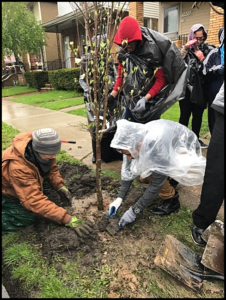Survey finds most of the city’s trees in good health

When approximately 500 trees were blown down in a 1997 tornado, the city and volunteers replaced most of them over the years. A recent survey found that most of all the city trees are in good health.
By Alan Madlane
Looks like Hamtramck can afford to throw a little shade.
In June, the city had a comprehensive tree survey completed for all city-maintained street rights-of-way, and for all maintained areas in the city’s parks.
The inventory and subsequent report were both done by the Davey Resource Group.
The results “wood” surprise many.
The full document goes on for 72 pages, but to summarize: The survey identified 3,282 different “sites,” a catch-all term for existing trees (1,911), stumps (116) and optimal “planting sites” (1,255).
There were 75 different specific species of tree identified. The top genus (one level of identity above the species level) was maple trees, at a whopping 43 percent. The Norway maple was the most common of these, at almost 60 percent of all maples and 25 percent of all the city’s trees.
Pear trees came in second at 14 percent; all of these are Callery pear.
The upshot? A full 58 percent of the city’s trees received the highest rating of health, at “Good.” Trees considered in “Fair” condition comprised another 29 percent, totaling 87 percent in at least “Fair” shape.
“Poor”-condition trees (5 percent) and “Dead” trees (8 percent) made up the rest.
Also of note is that many of the city’s trees are considered to be at an ideal size and age, both. The average diameter (measured at 4.5 feet off the ground on a tree’s trunk) skewed heavily toward trees between an inch and a foot around. A handful of elderly giants measured from 35 to more than 40 feet around.
Of all those trees, there were only six that the survey marked as a high priority to either remove (four) or prune (two). An even 100 require a moderate level of attention, in the eyes of the inventory crew.
In the end, the recommendations were summarized this way: Prioritize removals and pruning, based on the risk rating numbers, especially the pruning (most of the removals are dead, thus no longer growing); establish a strong planting program; limit the planting of maple family trees (genus diversity is always advised); and consider making this inventory a yearly endeavor.
By the way, keep your eye out for three of Hamtramck’s worst tree pests: the Asian Longhorn Beetle (ALB), the pretty but destructive Spotted Lanternfly, and the tiny Granulate Ambrosia Beetle.
All are considered native to the Indo-China area, and probably made their way over among the frequent shipments of imported goods from those areas.
Now, get some shade!
Aug. 9, 2019

